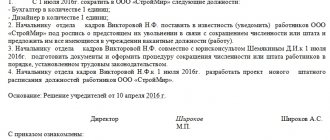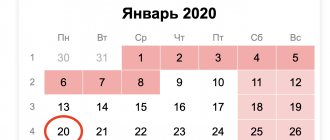For the management of any company, the question of what the number of personnel should be in order for it to function effectively is always important. Many enterprises are forced to lay off workers due to costs, which does not always have a positive effect on the development of production. There is a concept of the optimal number of people at which a company can operate effectively.
The higher the composition and number of employees of a company, the more difficult it is to manage it. Therefore, determining the optimal number of employees is an important point.
The number of personnel is one of the most important categories for personnel research in a company. It should not be higher or lower than the optimal indicator. Let's look at how to determine it.
Concepts to Consider
The number of personnel of the company is the most important personnel indicator of the company, which characterizes its condition. This concept can be specified by the concept of payroll, turnout and average number of staff units.
The headcount category refers to statistical and economic indicators that reflect the number of people who perform labor functions in a company and are part of various categories of workers.
Personnel composition
The structure is understood as the unification of its employees into groups and functioning units according to various criteria. The following groups are distinguished by composition, shown in the table below.
| Groups | Characteristic | Classification stage | Characteristic |
| Non-industrial | Those workers who are not directly involved in the production process. Workers of the social segment | _ | _ |
| Industrial production | Those employees who are involved in the production process | Company managers | -lower level (masters); -medium (managers of structural divisions); - senior (CEO, deputies) |
| _ | _ | Employees | Secretary, cashier, timekeeper, forwarder. All employees involved in documentation, financial and accounting work |
| _ | _ | Specialists | Engineers, economists, lawyers, technologists, personnel officers, accountants, etc. Performing administrative, economic, engineering, economic and legal tasks |
| _ | _ | Workers | Those who directly create the company's products, produce the final product, and provide services. |
The structure and number of personnel may be influenced by the following factors:
- Automation and computerization of production.
- Use of modern technologies.
- Use of the latest materials.
- Organization of production.
Staff
Staffing Staffing
is the number of permanent employees of an organization. Employees hired for seasonal or temporary work are not taken into account. Organizations often find it beneficial to hire specialists for a certain period of time, during the most important periods of activity. The presence of an employee on staff means that the employer is obliged to take care of the social and legal aspects of his work activity. Official registration and benefits package often become a burdensome expense item for an organization, especially if the need for an employee arises sporadically.
In such cases, specialized companies come to the aid of businesses and provide their staff on leasing terms. Leasing employees is convenient for both parties and is successfully used in many countries around the world.
The advantages of leasing include:
- savings on administrative and tax penalties;
- stability and qualifications of staff;
- reliability of cooperation, guaranteed results.
The personnel leasing service allows organizations to increase productivity without having to increase the number of employees.
If the number of employees on staff is already too large, but the reduction will lead to business stagnation, the manager has the right to turn to outstaffing services. This is the removal of employees from outside the organization’s staff in order to optimize costs. Outstaffing relieves the customer of the employer's responsibilities, while leaving the employee in the same place.
The positive aspects of the service are:
- reduction of direct costs of the customer organization and tax base;
- job cuts;
- reducing the burden on the HR department;
- avoidance of labor disputes;
- saving time by transferring work schedules and office work;
- quick search for a replacement for a permanent employee.
Despite the obvious difference between leasing and outstaffing services, both of them are aimed at optimizing the staff and the successful development of the client’s business.
Outsourcing companies offer not only these services, but also professional staff selection. Formation takes place taking into account all the requirements and wishes of management. Searching for employees on your own is less productive.
See also:
|
Number structure
It can include several categories of employees:
- Payroll.
- Employees performing labor functions under civil contracts.
- Part-timers.
The number of employees on the payroll is all the employees who work at the enterprise: full-time, seasonal, temporary, etc. The fundamental point is the fact that they all have an entry in the work book. Each such employee is counted as part of only one company. Also considered are those people who did not go to work for any reason. When calculating employment, this list is used. If a person is included in the payroll, therefore, he is not unemployed.
For those who work under civil contracts, contract agreements or labor agreements are concluded. Such employees may be employed in several companies during the reporting period and be considered full-fledged employees.
Their number cannot be determined without taking into account external and internal part-time workers. External part-time workers are employees who are usually on the list of one company, and part-time (according to labor relations laws) employed on projects in another organization. Internal part-time workers are company employees who additionally perform paid tasks in their own organization.
When calculating the average number of people, the work of external part-time workers is taken into account according to the time they spent. The subgroup the new person is included in is stated in the hiring order and in the contract concluded with the company. Part-time workers and those working on a contract basis are not included in the list for determining the employed share of personnel in order to prevent double counting.
Types of contracts
One of the following agreements may be concluded with a temporary worker who is hired by an enterprise to solve specific problems:
- Temporary (urgent) agreement. The document specifies the completion date of the work or indicates a number of works to be performed;
- Agreement for seasonal work. The document is usually drawn up for no more than 60 days (according to Article 45 of the Labor Code of the Russian Federation);
- Part-time job. A full-time employee is temporarily obliged to perform additional work with an increase in salary;
- Contract agreement (civil contract). It may be necessary for a person to perform specific work, and upon its implementation it ceases to be valid.
Types of numbers
Among the main types of personnel, the following are distinguished:
- Planned.
- Regulatory.
- Regular.
- Average pay.
- Appearance room.
- Factual.
The table shows the main types of personnel and their characteristics.
| Number | Characteristic |
| Planned | Can be determined by labor productivity factors and the specifics of the organization in the market. The indicator is close to reality |
| Regulatory | Formed on the basis of labor standards in the industry and the volume of work |
| Regular | Formed from the number of employees who are on staff excluding seasonal and temporary employees |
| Average salary | Determine the average number of employees for the period |
| Appearance | Only those employees who are currently at work |
| Actual | The number of actual employees in the company |
Reporting on the number of employees
Often at enterprises, management requires official documentary records of the number of employees. For this purpose, list data is compiled, which takes into account standards for determining the size of the company's staff.
The data entered in these lists must correspond to the number of employees included in the timesheet. This way you can record attendance effectively and without unnecessary labor costs.
Also, do not forget that when determining the number of employees, the recommendations developed by the labor inspectorate must be followed. After all, the correctness of your calculations will directly depend on this.
In particular, it is necessary to include in the staffing table all employees, without exception, with whom official long-term employment contracts have been concluded. It is also necessary to carefully record the persons who are officially awarded monetary remuneration for the performance of their duties.
An interesting point is that all employees must be included in the timesheet, even in cases where they do not report to their workplace. And it doesn’t matter for what reasons - valid or not. The final data available in the table must strictly correspond to the data that is in the timesheet.
Techniques
The analysis of the number of personnel of the organization is carried out in several stages, reflected in the table below.
| Stage | Characteristic |
| Comparison of the number and composition of staff with analogue organizations in the industry | The percentage ratio of qualitative and quantitative categories of composition is studied. Determine the standard ratio to the total number of personnel |
| Comparison of profit growth rates and costs for the entire company’s personnel | The rate of growth of the wage fund should be lower than the rate of increase in productivity |
| Recalculation of the hierarchy in the company | The ability to identify unnecessary links in management |
| Audit and revision of personnel | Analytics of personnel by age, length of service, gender, level of education, etc. |
Average number of employees
The average number of personnel can be determined using the formula presented below:
SrCh = (SrCh1+SrCh2+….SrCh12)/12. The denominator is the number of months in a year.
where СрЧ1, СрЧ2... is the average number of personnel by month of the year (persons).
To calculate the indicator SrCh1, SrCh2, etc. payroll values are used for months of the year, taking into account holidays and weekends.
An example of the calculation is presented below.
Initial data:
- The number at the end of December is 10 people.
- Since January 11, 15 more people have been accepted.
- On January 30, 5 people were fired.
The source data looks like this:
- From January 1 to January 10 - 10 people.
- From January 11 to January 29 – 25.
- From January 30 to January 31 -20.
Calculation of population indicators:
((10 days * 10 people) + (19 days * 25 people) + (2 days * 20 people))/31 = (100 + 475 + 40)/31 = 19.8 or rounded 20 people.
What types of headcount can you name?
Topic 6. Labor resources of enterprises
What is meant by the quantitative and structural characteristics of an enterprise’s personnel?
Personnel is the full complement of employees of an organization (with the exception of management) performing various production and economic functions.
The part of the personnel that is officially on its staff is called personnel.
Personnel characteristics:
n quantitative:
n payroll number (number of employees hired by the enterprise according to documents)
n attendance number (estimated number of payroll employees who must report to work on a given day to complete a production task)
n average number of employees (the sum of the number of employees on the payroll for each calendar day of the month (including holidays and weekends) is divided by the number of calendar days of the month)
n structural (composition and quantitative ratio of individual categories and groups of employees of the enterprise)
What categories are the company's personnel divided into?
Division of personnel by function
n Industrial - production personnel (directly involved in the production process, and also manages it) - personnel of the main activities.
n Non-industrial personnel (not directly related to product output: workers in housing and communal services, cultural, community and medical and sanitary institutions, etc., who are on the balance sheet of the enterprise)
Personnel by nature of work functions:
— Employees (managers (administrators), specialists (economists, sociologists, psychologists, etc.), other employees (cashiers, commandants));
— Workers (main (employed in technological processes), auxiliary (work in auxiliary departments), junior service personnel (janitors, couriers, etc.).
Personnel classification
Depending on the period:
n constants
n temporary
n seasonal
Division in international practice
n management employees (top, middle and lower level managers), engineering and technical personnel and office workers (“white collar”);
n manual workers (“blue collar” workers);
social infrastructure workers (“gray collar”).
Describe the methods for determining the number of employees at an enterprise?
— Total need (by sales volume per person, by profit before taxes, by value added);
— Demand by category (by labor intensity, by service standards, by the number of jobs, by staffing);
— Additional need (increase in numbers due to expansion of production, due to the need to compensate for retiring workers).
Method for determining the need for labor intensity of work
Q-volume unit products; NVR is the standard time per unit. products
Fef - useful. Working hours of 1st worker; KVN - coefficient
Compliance with standards.
The useful (effective) working time of one worker is determined based on the calculation:
n calendar fund of working time, which corresponds to the number of calendar days in a year;
n nominal working time, which is less than the calendar one by the number of weekends and holidays per year;
n useful (effective) working time fund, which is less than nominal by the amount of planned absences from work (vacation, illness, etc.).
What types of staff numbers can you name?
Headcount (Chsp
) employees of an enterprise - this is an indicator of the number of employees on the payroll as of a certain date or date. It takes into account the number of all employees of the enterprise hired for permanent, seasonal and temporary work in accordance with concluded employment contracts, as well as working owners of the organization who receive wages in it.
Turnout number
(Cha) characterizes the number of payroll employees who came to work on a given day, including those on business trips. This is the required number of workers to complete the production shift task for production. The difference between attendance and payroll characterizes the number of absentees for various reasons (vacation, illness, etc.). To bring the number of workers to the payroll, the coefficient for converting the number of workers to the payroll (Ksp) is used:
Average headcount
— the number of employees on average for a certain period (month, quarter, since the beginning of the year, for the year). The average number of employees per month is determined by summing the number of employees on the payroll for each calendar day of the month. In this case, the number of employees on the payroll for weekends and holidays is equal to the number of employees on the previous working day.
The average number of employees shows how many employees on average were on the enterprise's lists daily for the period under review. When determining the average number of employees, employees hired on a part-time or part-time basis (part-time workers) are taken into account in proportion to the time they actually worked. Homeworkers are counted as whole units. Some payroll employees are not taken into account when determining the average payroll (women on maternity leave, additional child care leave; employees on study leave without pay, etc.).
Planning
Personnel planning refers to the process of developing plans to provide the company with the required number of personnel.
The process solves the following problems:
- Lack of labor in the company.
- Lack of qualified personnel for business development.
The planning stages are shown in the table below.
| Stage | Characteristic |
| Analysis of the current state of affairs | Determining the compliance of company employees with existing requirements |
| Hiring Need Assessment | When exploring the following areas: -type of work of the company; - market features; -volume of production; - management tasks; -financial resources. The process can be carried out in accordance with how technically equipped the company is |
| Formation of a new composition | The process of attracting employees through recruitment itself |
| Efficiency mark | Calculation of performance indicators for attracting new employees |
Labor time recording standards
Since it is not easy to calculate the number of employees, it is necessary to take into account the standards for recording working hours. This will greatly facilitate the work of HR specialists. This indicator records the total working time costs that the head of an enterprise or the corresponding department sets for a specific employee or group of employees. The working time required to complete the task must be laid down at the stage of determining the technical and organizational conditions in accordance with which the task will be performed.
It is important to remember that the employees themselves must strictly correspond to the level of qualifications necessary to perform a certain task. Otherwise, the standards for recording labor time will have to be adjusted. Moreover, if employees are less qualified than required, then to a greater extent, which will lead to the fact that the final goal will be achieved much later than planned.
All work at the enterprise must be covered by these temporary standards. Only in this case will production function smoothly and smoothly. In addition, thanks to labor time tracking, you will receive objective data on the required number of personnel. At this stage, it is possible to revise the number of employees in the direction of increasing or decreasing the number of employees.
Standards
There are different staffing standards. Among them are production standards, service standards, etc. To find how many people are required to implement a certain labor function, calculations are used based on the number of personnel.
Reliance on standards allows you to plan the number and composition of the company's employees, which practically leads to a level of productivity that corresponds to the technical characteristics of the company.
Here are several calculation options.
Method 1. In accordance with production standards. They are defined as the amount of work (for example, the number of finished products) that a team (or an employee with sufficient qualifications) is required to complete in accordance with existing organizational criteria per unit of working time.
Method 2. In accordance with the size standard. The basis for this calculation is a fixed number of employees with certain qualifications required to solve managerial or industrial problems. The main disadvantage of using this standard is the not very high accuracy of the characteristics. This is due to the fact that only normal volumes are taken into account when determining staffing standards. The more complex the actual work process, the more it deviates from the typical one. Therefore, the accuracy of the calculation decreases.
Method 3. In accordance with time standards. Here you need to take into account the amount of time spent on implementing a unit of an industrial process by an employee or team.
Method 4. In accordance with service standards. In these calculations, the basis is the number of pieces of industrial equipment (for example, machine tools, animal heads) that a group of employees must process within a certain time. This rule is almost the same as for employees who perform service functions. Often, when calculating the number of employees in an organization (both regular and standard), the headcount indicators are fractional and require rounding. The obtained values are used as arguments for making various management decisions in the field of personnel policy.
Determination of staffing levels
In a broad sense, the number of employees is the number of employees of a company or enterprise included in its staff. Or this is the number that appears in the staffing table approved by the manager (this is a mandatory requirement).
It is also worth noting that seasonal workers or employees with whom you enter into temporary employment contracts are not included in the general staffing table. Therefore, they do not need to be taken into account.
The use of this concept has become especially widespread in business planning when determining the number of personnel. It is also quite often found when discussing the most effective solutions to management issues related to the development of an enterprise or company.
Optimal number of employees
To optimally calculate the number of personnel in the production area, other methods are used.
Method 1. Timing. For measurements, use a stopwatch and note how much time each subsequent step of the workflow takes. Then all acquired values are summed up. The timing method is used mainly by production managers, financiers and standard setters. The main disadvantage of this method is its labor intensity and duration, especially if the company has a significant number of employees.
For example, the average production time for a part can be calculated only after 30 measurements, during which the actions are carried out by different workers. However, the measurement accuracy will not be high enough. Work speed decreases for employees who know that they are being watched. Another disadvantage of timing is the lack of flexibility. If you need to calculate the production speed of identical parts that have minor differences, this can only be done through measurements for each of them.
Method 2. Comparison with rival companies. Optimizing the number of employees in an organization is also done by comparing the number of employees you have and those of your competitors using the same industrial technologies. This is an extremely fast method, but it will only bear fruit if real information about the work of competing companies is provided. Benchmarking also helps to understand where a company stands in the market based on employee numbers and business productivity.
Method 3. Microelement planning. This method is based on the assumption that any work operation can be reduced to a certain number of simple actions, and the time spent on them is already known. Then, to calculate the standard, only the sum of the measurement results will be needed. Based on this information, it will be possible to optimize the number of employees in the company. Rationing operations using microelements is only suitable for those types of work that are performed manually and consist of cyclic actions. To apply this method, you need a financier who has undergone special training.
Number of support workers
To calculate the number of personnel in the area of auxiliary operations, the factor planning method is used. It is quite labor intensive. In this case, key criteria are used for each process and production operation. Determining the degree of influence of factors on the number of personnel occurs as follows: the work process is divided into elements, each of which depends on one factor. The results of such standardization are compared with similar values in comparable divisions of the organization.










